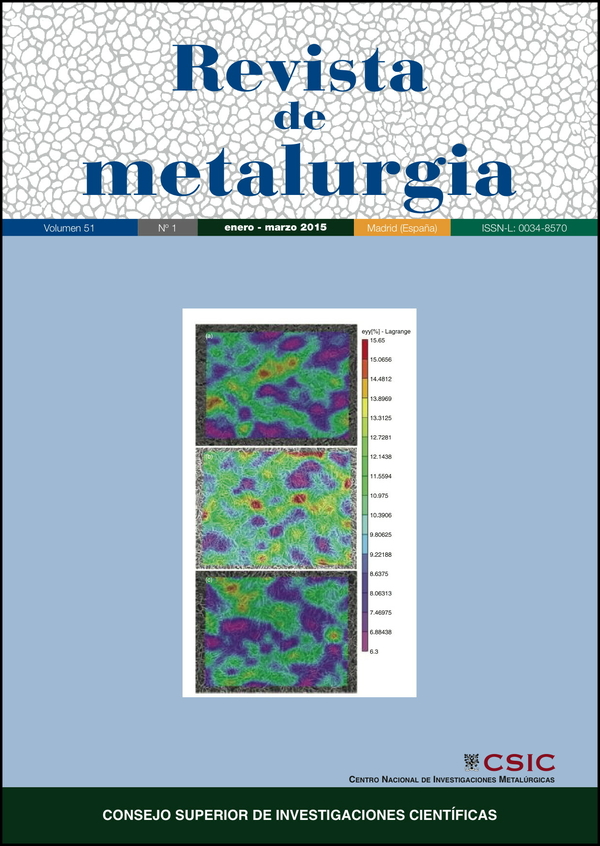Estudio de las características mecánicas y estructurales del platino y paladio a altas temperaturas
DOI:
https://doi.org/10.3989/revmetalm.038Palabras clave:
Deformación, Ensayo de tracción, Fluencia, Metales, RecocidoResumen
Se realiza un estudio comparativo de las propiedades mecánicas a alta temperatura del platino y paladio, con el fin de ampliar las aplicaciones de los productos basados en estos metales. El platino y el paladio son de gran importancia y se utilizan ampliamente en la industria química, electrónica y para la fabricación de placas de laboratorio, entre otras aplicaciones. Se estudiaron las siguientes propiedades mecánicas de los metales puros: resistencia a la tracción, velocidad de fluencia y tiempo de rotura bajo condiciones de fluencia. Para esas investigaciones se utilizó una máquina universal de ensayos para realizar los ensayos de tracción. La micro- estructura fue investigada por microscopía óptica. Basándose en los resultados obtenidos, se puede concluir que el platino, en comparación con el paladio, presenta mejores prestaciones para aplicaciones a alta temperatura.
Descargas
Citas
Biggs, T., Taylor, S.S., van der Lingen, E. (2005). The hardening of platinum alloys for potential jewellery application. Platinum Met. Rev. 49 (1), 2–15. http://dx.doi.org/10.1595/147106705X24409
Bliznakov, S., Vukmirovic, M., Sutter, E., Adzic, R. (2011). Electrodeposition of palladium nanowires and nanorods on carbon nanoparticles. Maced. J. Chem. Chem. Eng. 30 (1), 19–27.
Cagin, T., Dereli, G., Uludogan, M., Tomak, M. (1999). Thermal and mechanical properties of some fcc transition metals. Phys. Rev. B: Condens. Matter. 59, 3468–3473. http://dx.doi.org/10.1103/PhysRevB.59.3468
Desforges, A., Backov, R., Deleuze, H., Mondain-Monval, O. (2005). Generation of Palladium Nanoparticles within Macrocellular Polymeric Supports: Application to Heterogeneous Catalysis of the Suzuki-Miyaura Coupling Reaction. Adv. Funct. Mater. 15 (10), 1689–1695. http://dx.doi.org/10.1002/adfm.200500146
Edwards, J.K., Hutchings, G.J. (2008). Palladium and Gold-Palladium Catalysts for the Direct Synthesis of Hydrogen Peroxide. Angew. Chem. Int. Edit. 47 (48), 9192–9198. http://dx.doi.org/10.1002/anie.200802818 PMid:18798185
Fischer, B. (1992). Reduction of Platinum Corrosion in Molten Glass. Platinum Met. Rev. 36 (1), 14–25.
Funabiki, M., Yamada, T., Kayano, K. (1991). Auto exhaust catalysts. Catal. Today 10 (1), 33–43. http://dx.doi.org/10.1016/0920-5861(91)80072-H
Gavin, H. (2010). Platinum group metals research froma global perspective. Platinum Met. Rev. 54 (3), 166–171. http://dx.doi.org/10.1595/147106710X500125
García-Ochoa E.M., Genescá J. (2000). EIS and electrochemical noise study of anodic passivation of palladium in alkaline medium. Rev. Metal. 36, 3–12. http://dx.doi.org/10.3989/revmetalm.2000.v36.i1.492
González-López S., Romero-Serrano A., Vargas-García R., Zeifert B., Cruz-Ramírez A. (2010). Analysis of the deoxidation process of copper with manganese using a platinum electrode-based sensor prepared by MOCVD. Rev. Metal. 46 (3), 219–226. http://dx.doi.org/10.3989/revmetalm.0927
Kim, K.B., Kim, Y.H., Song, K.S., Park, E.D. (2011). Propane combustion over Pt catalysts supported on zeolites. Rev. Adv. Mater. Sci. 28 (1), 35–39.
Kordas K., Nánai L., Bali K., Stepan K., Vajtai R., George T.F., Leppävuori, S. (2000) Palladium thin film deposition from liquid precursors on polymers by projected excimer beams. Appl. Surf. Sci. 168 (1–4), 66–70. http://dx.doi.org/10.1016/S0169-4332(00)00592-4
Loginov, Yu.N., Yermakov, A.V., Grohovskaya, L.G., Studenok, G.I. (2007). Annealing Characteristics and Strain Resistance of 99.93 wt.% Platinum. Platinum Met. Rev. 51 (4), 178–184. http://dx.doi.org/10.1595/147106707X237708
Ning, Y., Yang, Z., Zhao, H. (1996). Platinum recovery by palladium alloy catchment gauzes in nitric acid plants. Platinum Met. Rev. 4 (2), 80–87.
Ohm, W.S., Hill, K.D. (2010). A Mechanism for the Oxidation-Related Influence on the Thermoelectric Behavior of Palladium. Int. J. Thermophys. 31 (8–9), 1402–1416. http://dx.doi.org/10.1007/s10765-010-0748-2
Preston, E. (1960). Platinum in the glass industry. Platinum Met. Rev. 4, 48–55.
Ritvin, E.I., Medovoj, L.A. (1974). Vlianie fiziko-himicheskoj sledi na zharoprochnost merallicheskih materialov. Nauka, Moskva.
Ritvin, E.I. (1987). Zharoprochnost platinovih splavov. Metalurgija, Moskva, Russian.
Redon, R., Rendon-Lara, S.K., Fernández-Osorio, A.L., Ugalde-Saldivar, V.M. (2011). Aerobic synthesis of palladium nanoparticles. Rev. Adv. Mater. Sci. 27, 31–42.
Savickij, E.M., Poljakova, V.P., Gorina, N.B., Roshan, N.R. (1975). Metalovedenie platinovih metalov. Metalurgija, Moskva, Russian. PMid:1223965
Singh, J., Alayon, E.M.C., Tromp, M., Safonova, O.V., Glatzel, P., Nachtegaal, M., Frahm, R., van Bokhoven, J.A. (2008). Generating Highly Active Partially Oxidized Platinum during Oxidation of Carbon Monoxide over Pt/Al2O3: In Situ, Time-Resolved, and High-Energy-Resolution X-Ray Absorption Spectroscopy. Angew. Chem. Int. Edit. 47 (48), 9260–9264. http://dx.doi.org/10.1002/anie.200803427 PMid:18972471
Trumic´, B., Stankovic´, D., Trujic´, V. (2009). Examining the surfaces in used platinum catalysts. J. Min. Metall. Sect. B. 45 (1), 79–87. http://dx.doi.org/10.2298/JMMB0901079T
Trumic´, B., Stankovic´, D., Ivanovic´, A. (2010). The impact of cold deformatioon, annealing temperatures and chemical assays on the mechanical properties of platinum. J. Min. Metall. Sect. B. 46 (1), 51–57. http://dx.doi.org/10.2298/JMMB1001051T
Trumic´, B., GomidÏelovic´, L., Trujic´, V., Krstic´, V., Stankovic´, D. (2012). Comparative analysis of high temperature strength of platinum and its binary alloys with low content of alloying element. Hem. Ind. 66 (3), 395–401. http://dx.doi.org/10.2298/HEMIND110718106T
Wright, J.C. (2002). Jewellery-Related Properties of Platinum: Low Thermal Diffusivity Permits Use of Laser Welding for Jewellery Manufacture. Platinum Met. Rev. 46 (2), 66–72.
Wu, B., Liu, G. (1997). Platinum: Platinum-rhodium thermocouple Wire. Platinum Met. Rev. 41, 81–85.
Xiao, F., Zhao, F., Mei, D., Mo, Z., Zeng, B. (2009). Nonenzymatic glucose sensor based on ultrasonic-electrodeposition of bimetallic PtM (M=Ru, Pd and Au) nanoparticles on carbon nanotubes–ionic liquid composite film. Biosens. Bioelectron. 24 (12), 3481–3486. http://dx.doi.org/10.1016/j.bios.2009.04.045 PMid:19524431
Yuantao, N., Zhengfen, Y. (1999). Platinum loss from alloy catalyst gauzes in nitric acid Plants. Platinum Met. Rev. 43 (4), 62–69. http://www.technology.matthey.com/article/43/4/167-167-2/.
Publicado
Cómo citar
Número
Sección
Licencia
Derechos de autor 2015 Consejo Superior de Investigaciones Científicas (CSIC)

Esta obra está bajo una licencia internacional Creative Commons Atribución 4.0.
© CSIC. Los originales publicados en las ediciones impresa y electrónica de esta Revista son propiedad del Consejo Superior de Investigaciones Científicas, siendo necesario citar la procedencia en cualquier reproducción parcial o total.
Salvo indicación contraria, todos los contenidos de la edición electrónica se distribuyen bajo una licencia de uso y distribución “Creative Commons Reconocimiento 4.0 Internacional ” (CC BY 4.0). Consulte la versión informativa y el texto legal de la licencia. Esta circunstancia ha de hacerse constar expresamente de esta forma cuando sea necesario.
No se autoriza el depósito en repositorios, páginas web personales o similares de cualquier otra versión distinta a la publicada por el editor.
















